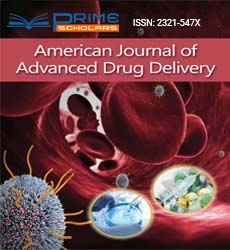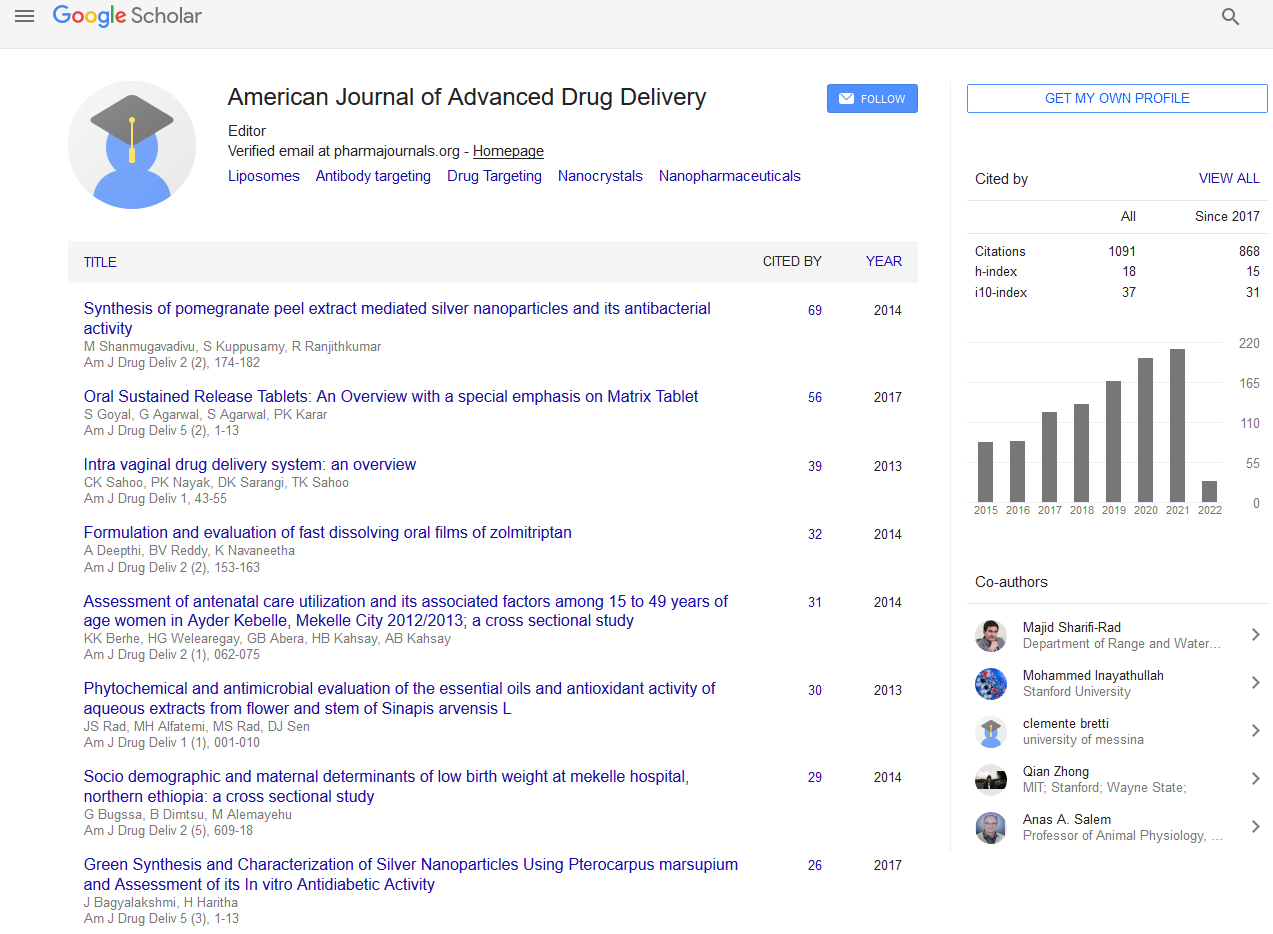Review Article - (2025) Volume 12, Issue 1
Nose to Brain Drug Delivery System
Kshitij Kumar*
Department of Biotechnology, Jaypee Institute of Information Technology (JIIT), Sector-62, Noida, India
*Correspondence:
Kshitij Kumar, Department of Biotechnology, Jaypee Institute of Information Technology (JIIT), Sector-62, Noida,
India,
Email:
Received: 11-Nov-2023, Manuscript No. IPAAD-23-18314;
Editor assigned: 14-Nov-2023, Pre QC No. IPAAD-23-18314 (PQ);
Reviewed: 18-Nov-2023, QC No. IPAAD-23-18314;
Revised: 11-Jan-2025, Manuscript No. IPAAD-23-18314 (R);
Published:
18-Jan-2025
Abstract
The nose-to-brain drug delivery system has emerged as a promising approach for the targeted delivery of therapeutics to the Central Nervous System (CNS). This non-invasive and efficient method bypasses the blood-brain barrier, allowing drugs to reach the brain directly through the olfactory and trigeminal pathways. This abstract provides an overview of the key advancements and applications of the nose-to-brain drug delivery system. Recent developments in nanotechnology, such as nanoparticles and liposomes, have enabled the encapsulation of various drugs, including neuroprotective agents, peptides, and small molecules, for precise delivery to the brain. These advancements have opened new possibilities for the treatment of neurodegenerative diseases, brain tumors, and neurological disorders. Furthermore, the nose-to-brain route offers advantages such as rapid onset of action, reduced systemic side effects, and improved patient compliance. It has found applications in the treatment of Alzheimer's disease, Parkinson's disease, migraine, and epilepsy, among others. This abstract highlight the potential of the nose-to-brain drug delivery system as a valuable tool in neuropharmacology and neuroscience research, offering hope for more effective treatments for a wide range of Central Nervous System (CNS) related conditions. However, further research is needed to optimize delivery strategies, ensure safety, and maximize therapeutic outcomes in clinical settings.
Keywords
Central Nervous System (CNS); Alzheimer's disease; Parkinson's disease; Migraine; Epilepsy
Introduction
The nose to brain delivery system always remains a challenge for scientists. This delivery approach is a highly advanced approach for the treatment of various disorders related to the brain and is still under investigations with various successful lab scale studies and numerous challenges to reach the pharmacy counter. It is a very innovative, convenient and noninvasive method. Nose to brain drug delivery system is an excellent route in which drugs are imitated to the nasal route for systemic effect. This type of delivery system is used in all the therapeutic compounds including pharmaceuticals and biopharmaceuticals.
In this route, nasal mucosa is used to attain a rapid and higher level of drug absorption. Nasal cavity has a larger surface area, avoidance to first pass metabolism, porous endothelial membrane and high total blood flow are some advantages to this system. Scientists are fascinated in the nasal route for the systemic delivery of therapeutic substances due to their high degree of permeability of nasal mucosa. This system is still under investigation as the major challenge behind is mode of delivery is the presence of physiological barriers, blood brain barrier and blood cerebrospinal fluid barrier that prevents the entry of drugs to the central nervous system.
The nose to brain approach follows a direct transport pathway of drugs through olfactory and trigeminal nerve cells through the nose by circumventing the blood brain barrier and entering the brain directly. Olfactory region is directly linked to the cerebrospinal fluid barrier and thus acts as a lead in nose to brain drug delivery system.
In nose to brain delivery, drugs are permeated through the blood brain barrier from the circulation. Through active and passive transportation, the drug or pro-drug are absorbed to bypass the tight junctions of the blood brain barrier. Drugs given through the nasal pathway are directly transported to the brain either by direct transport from olfactory region to the brain and from blood to brain or cerebro-spinal fluid.
The drug is directly absorbed into the brain by various mechanisms like transcellular, paracellular, olfactory and trigeminal neural pathways. On nasal instillation, the drug formulation comes in contact with nasal mucosa and it reaches directly into the brain by circumventing the Blood Brain Barrier (BBB). By respiratory region, some amount of administered drugs reaches systemic circulation whereas, some number of drugs are lost to nasal associated lymphoid tissue.
The hydrophobic (lipid soluble) molecules can easily bypass blood brain barrier and enter to the bloodstream from nasal mucosa and reach the central nervous system. But maximum biopharmaceutical and pharmaceutical compounds are hydrophilic (water soluble) in nature which is a rate limiting barrier for targeting. Due to the high partition coefficient (higher lipophilicity) of highly lipid soluble drugs, molecules show an enhanced targeting ability (Figure 1) [1].
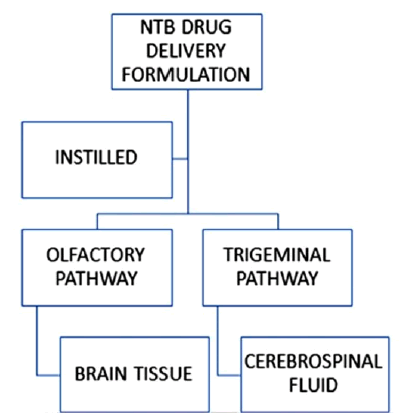
Figure 1: Flow chart indicating general mechanism of NTB formulations.
Literature Review
In the past few years, many drugs, proteins and peptides are delivered systematically by using the nose to brain delivery system. This delivery system is used to treat a variety of central nervous system disorders like brain tumours, Parkinson disorder, multiple sclerosis, Alzheimer disorder, epilepsy and psychiatric disorders (Table 1) [2].
| Pros |
Cons |
| It is a safe, invasive and convenient mode of drug delivery. |
Enzymatic degradation in the nasal milieu. |
| It avoids degradation of drugs in GIT. |
High molecular weight drugs and hydrophilic drugs cause low permeability. |
| CNS targeted drug delivery by passing BBB. |
Small volume of drug can be administered (25-200 mcg/L in humans). |
| Bioavailability is enhanced for the drugs having low molecular weight. |
Mucosal toxicity may arise from the use of absorption enhancers. |
| As the size of the drugs being delivered is very less, they have a large absorption area (160 cm2 in humans). |
Nasal congestion may cause problems in this method of drug delivery. |
| As the drugs are self-administered this increases the patient compliance. |
Improper technique of drug administration may cause mechanical loss of the drug. |
Table 1: Advantage and disadvantage of nose to brain drug delivery system.
Anatomical and Physiological Feature of Nasal Cavity
Nasal cavity is the basic route of air entry. Regarding physiology, the nasal cavity performs respiration and olfaction. Nasal cavity is the most efficient first line of defense for the body’s airway, working as a filter for particles or microbes that are entrapped in the nasal vestibule or in the mucus layer. It is also responsible for various physiological functions such as MCC, inhaled air before it reaches the lower part of the airways and converting them into the compounds that are easily eliminated in the exhaled air [3].
The nasal cavity extends from the outer opening of the nose to the pharynx. The nasal cavity contains bone covered with epithelium. The outer opening of the nose is made up of bone and nasal cartilage. The inner part of the nose consists of a nasal septum that divides the nasal cavity into two compartments. The top of the nasal cavity contains a tissue called the olfactory epithelium. It is useful for the sense of smell because it contains sensory cells that protrude from its surface and are wrapped in mucus secreted by epithelial goblet cells.
Sensory signals are transmitted to the brain by these cells. The nasal cavity is surrounded by paranasal sinuses which are identified by the vacant structures present in the bones of the face. There is presence of epithelial lining on the paranasal sinuses and is characterized as maxillary, frontal, ethmoidal and sphenoidal sinuses. The maxillary sinuses are found adjacent to the nasal cavity on both the sides and are the largest sinuses. They are attached to the nasal cavity by a tiny passage which allows air to pass through this. The frontal sinuses are isolated from the nasal cavity by a thin layer of bone. They are not attached to the nasal passages. The ethmoidal sinuses are also called as air chambers with varying size and number in different individuals. The sphenoidal sinuses vary in number and it is of round shape [4].
The nasal cavity is divided into two irregular cavities by the septum. The volume of each cavity is nearly about 13 mL and the surface area of 150 cm2. Both the cavities comprise of three different regions: Vestibular region, respiratory region, olfactory region [5].
Vestibular region: This is the anterior most part of the nasal cavity having surface area of 0.6 cm2. There is minimal absorption of drugs in this region because of the smaller surface area. This region has nasal hair which helps to filter the inhaled air [6].
Respiratory region: The respiratory region is the most vascularised region and has a surface area of 130 cm2.
Here, in this region drug absorption takes place. The surface of this zoneis covered by lateral walls of nasal cavities including the three conchae or turbinates. It contains four types of cells: Goblet, basal, ciliated columnar cells and non-ciliated columnar cells. Goblet cells secrete mucus which traps the inhaled particulate and the propulsive force which is basically started by the ciliated cells which transports the mucus towards the nasopharynx as well as gastrointestinal tract for elimination. This effective cleansing mechanism is called MCC. Basal cells are attached to the basement membrane and located on the basolateral part of the epithelium. The other two cells possess numerous microvilli and cilia [2,7].
Olfactory region: The olfactory region is present on the top of the nasal cavity. The surface area of the olfactory region is 15 cm2. From the structural point of view, this region is made up of pseudo stratified epithelium. This region is basically used for smell purposes. Various minor serous glands are present in this region known as glands of bowman which works as a solvent for odorous substances. Three types of cells are present in this region: Olfactory neural or axon cells, the supporting or sustentacular cells and the basal cells. The axon cells are unmyelinated and are present in between the supporting or sustentacular cells. The basal cells are the progenitor of sustentacular cells. Axon cells help in transportation of nanoparticles to the olfactory bulb into the olfactory cortex of the brain region and then, they plunge into the cerebral hemisphere and finally reach to the cerebellum and cerebrum (Table 2) [8].
| API |
Pharmacological effects |
| Solutions |
| Insulin |
Improved memory in Alzheimer’s disease patients. |
| Insulin |
Increased cognition in paediatric patients with 22q13 deletion syndrome. |
| Insulin |
Reduced nicotine craving in smokers. |
| Oxytocin |
Reduced the post-traumatic stress disorder response in humans. |
| Oxytocin |
Improved ability to emotionally rate faces in patients with autistic spectrum disorder. |
| Solid lipid nanoparticles |
| Valproic acid |
Protects against seizures in a rat seizure model. |
| Chitosan nanoparticles |
| Pramipexole |
Corrected motor deficits in a rat model of Parkinson’s disease. An enhanced pharmacological response when compared to the drug in solution. |
| Plasmid encoding for red fluorescent protein |
Gene expression in the striatal region of mice brains. |
| Mesenchymal-epithelial transition nanoparticles |
| Leucine-5-enkephalin |
Anti-nociception in spinal, thermal and paw inflammation pain mouse and rat models. |
| Propofol |
Sedation in a healthy rat model. |
| Poly (lactic-co-glycolic acid) nanoparticles |
| Oxcarbazepine |
Reduced seizures in a rat seizure model. |
| Poly (lactic-co-glycolic acid) nanoparticles coated with trimethyl chitosan |
| Huperzine A |
Increased brain exposure when compared to uncoated PLGA nanoparticles. |
Table 2: Nose to brain formulation types.
Liposomes: These are ideal drug carrier systems because of their similar morphological characteristics as that of the cell membrane. Small liposomes are allowed to pass through these membranes to reach BBB. The pores present in para cellular tight junctions also facilitate its movement.
Solid lipid nanoparticles: They are colloidal particles which are solid at both room temperature as well as body temperature. The active substances are located in the core. SLNs help in increasing the solubility of the drug hence in turn enhances the permeability of the drugs. They can be prepared by simple machines and do not need sophisticated equipment.
Nano emulsion: These are either oil in water or water in oil kind of drug formulation. This kind of drug delivery to the CNS is quite effective because it can easily cross the BBB and reach CNS. Its small size also adds to its property of easier drug permeability. A suitable surfactant is used to make both the immiscible phase stable with each other.
Niosomes: They have a unique structure because they can encapsulate both hydrophilic as well as hydrophobic drugs within it. They are also easy to store and handle and do not require specific requirements for storage. Apart from these qualities low cost, easy formulation technique and good stability makes it very popular for use as compared to liposomes.
Cubosomes: They are stable nanoparticles which are made from lipid phase which is cubic in nature. This is stabilized by the polymer based outer layer. This also carries both hydrophilic as well as hydrophobic drugs within its core. High internal surface area as well as its cubic structure helps in the better entrapment of the drugs as compared with liposomes. But there is one drawback associated with it is its large scale production becomes a hurdle due to its high viscosity.
Factors Influencing Nose to Brain Delivery of Nanoparticles
Particle size: Particle size plays a pivotal role in the delivery of small particles. Regarding NTB drug delivery, it plays a very efficient role as the small particles face less resistance against mucus penetration and migration along the absorption path. Larger particles are not able to migrate further as they are retained in the nasal mucosa. A lot of research work is done on this and it can be concluded that the smaller particles can travel to a larger distance in the NTB drug delivery system [9].
Surface modification: Sometimes nanoparticles might not be able to translocate the long distance to the brain. In order to resolve this problem, surface modifications are done with ligand. CPP enhances the translocation of nanoparticles in NTB drug delivery systems [9].
NMC: It is the main factor which affects the nasal residence of drugs. The mucus traps the inhaled particle and it is transported to the pharynx at a speed of 8-10 mm/h. Thus, NMC provides a very limited time for drug absorption. NMC is inhibited by bio adhesion and stimulated by mucociliary movement and expedite clearance [9].
Route of Drug Transport from Nose to the Brain
The mechanism of drug delivery from nose-to-brain is not fully discovered but it is believed that it is either transported directly or indirectly. In the direct method of drug delivery, the drug is transported into the brain via trigeminal or olfactory pathways but in the indirect method of drug transport the drug is first absorbed in the systemic circulation then finally crosses the blood brain barrier (Figure 2).
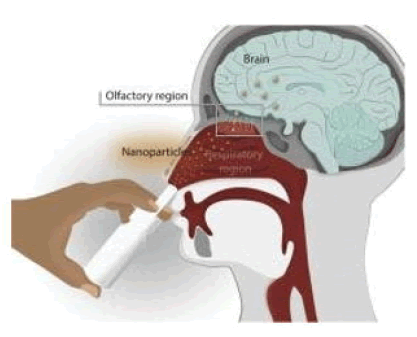
Figure 2: Route of drug transport from nose to brain.
Drugs after being administered in tranasally move from the vestibular region to the posterior region of the nasal cavity. This is absorbed through the epithelium into the blood or the lymphatic system. This pathway is called as the transcellular delivery. The drug needs to cross the BBB which after that undergoes hepatic drug metabolism to reach the systemic circulation.
Drugs after passing the vestibule reach the respiratory epithelium. Some of them are transported through the branches of trigeminal nerve but its contribution in the direct nose-to-brain is very small. In the innermost olfactory region small portion of the drugs reaches by two routes:
Intracellular: This type of transport of drugs takes place into the neurons.
Extracellular: This type of transport occurs across the spaces between the cells (Figure 3) [10].
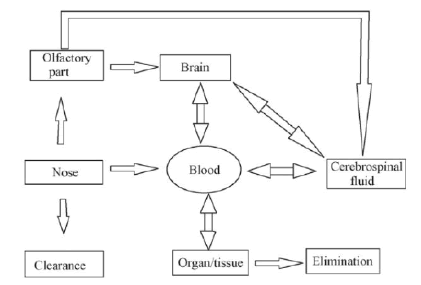
Figure 3: Various routes of drug transport from nose to the brain.
Factors Affecting the Drug Transport
Factors affecting drug delivery to the brain:
- High molecular weight.
- Enzymatic degradation.
- Poor nasal penetration.
- Rapid mucociliary movement.
Models for Testing Direct Nose-to-Brain Delivery
There are three main models used for drug delivery systems which include in vitro, in vivo and ex vivo models. Permeation and diffusion studies are done in vitro technique. Nasal absorption is studied in vivo models while nasal perfusion is studied in ex vivo techniques [2]. Mouse and rat models are used to study nose-to-brain drug absorption. The rat model was the first animal model in which this study was carried out. Rabbit; rat and sheep models were also used for pharmacokinetic studies example [11].
In vivo models: Anatomical and physiological difference of the nasal cavities the result obtained from animal model was not same as those of humans. For the nasal delivery the drug need to be soluble even in few microliters of the solvent. It should also be kept in mind that the nasal clearance is very fast so the drug should be dissolved before being absorbed. There is a difference in the olfactory region area in animals as well as humans. In humans the olfactory region covers only 10% of the nasal cavity while mice and rat covers 50% of the nasal cavity. This clearly shows that the result can vary between the animal studies with that of human.
In vitro models: In vitro studies deals with the mechanism of nasal absorption and the drug transport across the cells or para-cellular movements. There are basically two cell lines i.e. RPMI 2650 and CaCo-2 in which these studies are carried out. RPMI 2650 is basically a human nasal epithelial tissue. This cell line does not form a monolayer but it is present in the form of multilayer. Hence it is used for toxicity assay and nasal metabolism studies. CaCo-2 cell line is used to study nasal absorption of the formulation. This is the most suitable model to study drug absorption and permeability.
Ex vivo models: Ex vivo animal tissue models include rats, rabbits, dogs, sheep, monkeys and humans. Different properties such as permeation, metabolism efflux and toxicity are studied through these models. This model is very simple and easy to monitor. Passive diffusion, active transport and efflux transport is determined. Ex vivo models are popularly used as drug screening models during the early phase of drug delivery development [2].
Methods to Enhance Drug Absorption
Enzyme inhibitors: Enzymatic environment leads to the degradation and metabolism of certain drugs which actually leads to “pseudo” first pass effect. Enzymatic inhibitors prevent the degradation of the drugs which in turn causes the better absorption into the brain.
Permeation enhancers: They have low molecular weight which actually promotes the absorption of active quantities. Fatty acids, cyclodextrins, hydrophilic polymers, surfactants and bile salts are used as permeation enhancers. They target the olfactory epithelium which causes the movement of drugs from the olfactory bulb and CNS.
Vasoconstrictors: These are used as nasal decongestants. They constrict the dilated blood vessels which increase the blood pressure, reducing swelling and in turn relieve nasal congestion symptoms. They reduce the amount of drug absorbed into the systemic circulation via the respiratory epithelium and provide higher specificity to the CNS through the olfactory pathway. They also prevent the adverse effects due tohis systemic exposure.
Efflux transporters: They are rarely associated in the drug transport through the nasal mucosa. Studies are being carried out to observe its effect in the drug movement into the CNS.
Discussion
The Role of Nanovehicles
Nanovehicles are used to increase the solubility as well as stability which in turn increase the bio-adhesiveness. These are used when the conventional methods like solubilizers, absorption enhancers, stabilizers and mucoadhesive materials fail to exhibit their actions. Various contributions of nanovehicles in nose-to-brain delivery are given below.
Stability and solubility of drug: Sufficient nasal resident time is the prerequisite to enhance the trans-membrane absorption. Solubilizers and stabilizers are used to overcome poor solubility and instability. Various lipid based nanoparticles such as nanomaterial, Solid Lipid Nanoparticles (SLN), Nanostructured Lipid Carriers (NLC) are used to solubilize poorly soluble drugs which helps in efficient nasal drug delivery.
Sustained release: If the drugs have high permeability then these are directly delivered to the nasal epithelia but if they have difficulty in crossing the BBB then the amount of drug reaching the brain is very low. Sustained release by nanovehicles slow down the absorption rate and helps in prolonged and stable drug release. It is still being debated whether gels are also used to achieve sustained release or not because these are present as networks which basically release drugs at mucous surface.
Increased intranasal residence time: Nanovehicles which include various mucoadhesive materials such as chitosan and its derivatives are useful in increasing the residence time of the formulation in the nasal cavity. Different physicochemical properties which include particle size and surface charges also helps in prolonging the residence time of the drugs in the nasal cavity (Figure 4).
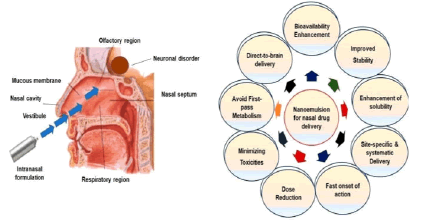
Figure 4: Intranasal nanoemulsion for direct Nose-to-brain delivery of active for CNS disorders.
Limitations of Nasal Drug Delivery
- Poor drug permeability from nasal mucosa.
- Mucociliary clearance.
- Enzymatic drug degradation.
- Short drug retention time.
- Nanomucosal toxicity.
Conclusion
Delivering drugs to the brain for treating major CNS disorders has always posed a significant challenge. This challenge arises from several issues, including reduced drug bioavailability due to enzymatic degradation, the inability to penetrate the Blood-Brain Barrier (BBB), drug breakdown due to intestinal degradation or first-pass metabolism, and lower blood perfusion. To address these issues, various drug delivery devices have been developed with a focus on minimizing side effects, ease of handling, cost-effectiveness, and low toxicity. Lipophilic drugs have an advantage in crossing the blood brain barrier.
Nose-to-brain drug delivery has emerged as a promising alternative to oral drug delivery. In this approach, various lipid-based nanoparticles, such as liposomes, solid lipid nanoparticles, nanoemulsions, niosomes, and cubosomes, play a pivotal role. Extensive studies are underway using different models, and if preclinical and clinical data align, it could represent a significant advancement in the field of science.
Some significant roles of these technologies are:
- Targeted therapy
- Bological approaches
- Nanotechnology
- Biompatible material
- Personalized medicine
References
- Crowe TP, Greenlee MH, Kanthasamy AG, Hsu WH (2018) Mechanism of intranasal drug delivery directly to the brain. Life Sci. 195:44-52.
[Crossref] [Google Scholar] [PubMed]
- Cunha S, Amaral MH, Lobo JS, Silva A (2017) Lipid nanoparticles for nasal/intranasal drug delivery. Crit Rev Ther Drug Carrier Syst. 34(3):257-282.
[Crossref] [Google Scholar] [PubMed]
- ErdÅ? F, Bors LA, Farkas D, Bajza Á, Gizurarson S (2018) Evaluation of intranasal delivery route of drug administration for brain targeting. Brain Res Bull. 143:155-170.
[Crossref] [Google Scholar] [PubMed]
- Abolhasanzadeh Z, Ashrafi H, Badr P, Azadi A (2017) Traditional neurotherapeutics approach intended for direct nose to brain delivery. J Ethnopharmacol. 209:116-123.
[Crossref] [Google Scholar] [PubMed]
- Feng Y, He H, Li F, Lu Y, Qi J, et al. (2018) An update on the role of nanovehicles in nose-to-brain drug delivery. Drug Discov Today. 23(5):1079-1088.
[Crossref] [Google Scholar] [PubMed]
- Wang Z, Xiong G, Tsang WC, Schätzlein AG, Uchegbu IF (2019). Nose-to-brain delivery. J Pharmacol Exp Ther. 370(3):593-601.
[Crossref] [Google Scholar] [PubMed]
- Hong SS, Oh KT, Choi HG, Lim SJ (2019) Liposomal formulations for nose-to-brain delivery: Recent advances and future perspectives. Pharmaceutics. 11(10):540.
[Crossref] [Google Scholar] [PubMed]
- Bonferoni MC, Rossi S, Sandri G, Ferrari F, Gavini E, et al. (2019) Nanoemulsions for “nose-to-brain” drug delivery. Pharmaceutics. 11(2):84.
[Crossref] [Google Scholar] [PubMed]
- Islam SU, Shehzad A, Ahmed MB, Lee YS (2020) Intranasal delivery of nanoformulations: A potential way of treatment for neurological disorders. Molecules. 25(8):1929.
[Crossref] [Google Scholar] [PubMed]
- Savale S, Mahajan H (2017) Nose to brain: A versatile mode of drug delivery system. Asian J Biomater Res. 3(1):16-38.
- Bourganis V, Kammona O, Alexopoulos A, Kiparissides C (2018) Recent advances in carrier mediated nose-to-brain delivery of pharmaceutics. Eur J Pharm Biopharm. 128:337-362.
[Crossref] [Google Scholar] [PubMed]
Citation: Kumar K (2025) Nose to Brain Drug Delivery System. Am J Adv Drug Deliv. 12:41.
Copyright: © 2025 Kumar K. This is an open-access article distributed under the terms of the Creative Commons Attribution License, which permits unrestricted use, distribution, and reproduction in any medium, provided the original author and source are credited.
